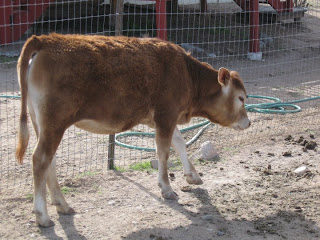 As I’ve said many times, I have a Jersey dairy cow named Cookie, a jersey calf and a gelding Quarter Horse named Dandy (he came named that way… I call him DoDa from the Yankee Doodle Dandy song) Anyway… I had two jersey cows up until a week ago when I took one, who was still in milk, into the butcher. (Another side note… I had to take her into the butcher – there was no way I could pull the trigger staring my Sally cow in the eyes)
As I’ve said many times, I have a Jersey dairy cow named Cookie, a jersey calf and a gelding Quarter Horse named Dandy (he came named that way… I call him DoDa from the Yankee Doodle Dandy song) Anyway… I had two jersey cows up until a week ago when I took one, who was still in milk, into the butcher. (Another side note… I had to take her into the butcher – there was no way I could pull the trigger staring my Sally cow in the eyes)
Why did I take a pure bred Jersey cow who was still in milk to the butcher??? FEED PRICES!!! Sally had a detachment in her left rear quarter and it was a battle to milk that section. She stood statue still and was a great cow, I just had to hold up the bag and massage a lot to get the milk out. (Detachment is when the milk making part of the quarter detaches from up top and falls to the bottom of the bag) Sometimes the blood supply is cut off when this happens and the quarter dries up naturally. Unfortunately, that was not the case with Sally.
Now, back to our regular program…. So, I took Sally to the butcher, not because Cookie wouldn’t love to have her as a dry cow buddy, but because I couldn’t AFFORD to feed a dry cow buddy. You see a few years ago (2008 / 2009) when gas shot up to almost $5.00 a gallon, feed shot up. A three string bale of alfalfa (90 lbs or so) went from $8.99 to $14.99 per bale in a matter of weeks. (Remember, I live in Arizona where everything has to be trucked in) Corn, Oats and Barley also shot up as did Estrella alfalfa pellets and chicken crumble. Prices didn’t really drop too much until very late 2009 and the prices didn’t drop anywhere near where they started before gas skyrocketed… Then late 2010 gas prices started to skyrocket again… but went no where near as high as it had last time… peaked around $3.90 instead of $4.80 a gallon… FEED however went significantly higher than it had before. I am currently paying $16.99 for a light three string bale of Alfalfa, I’m paying $14.99 for a 50 # bag of corn, oats and barley with molasses and $11.99 for a 50# bag of Estralla alfalfa pellets… Before I took Sally to butcher – my feed bill was pushing $800.00 per month! I pay less than that for my house payment!
So, I’m curious, with the commodities market raking havoc on grain prices and gas prices jumping up, little down and then up more… how are you fairing with feed prices? Now you all see why I’m trying so hard to save up for land with pasture… mid west here I come!





